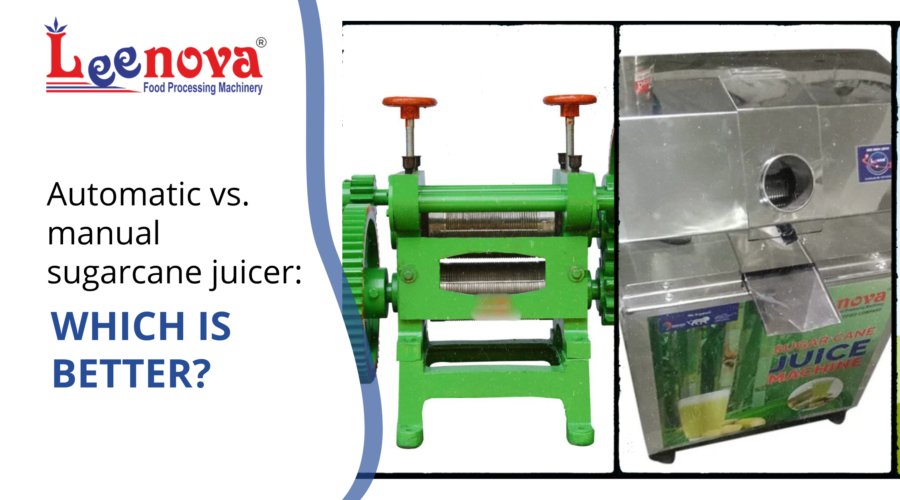Introduction: Choosing the Right Juicer for Your Business
As summer kicks in, the demand for fresh sugarcane juice skyrockets. Whether you run a juice stall, a café, a restaurant, or even a catering business, having the right sugarcane juicer can be the difference between long queues of happy customers and a frustratingly slow service.
But here’s where most business owners get stuck—should you go for a manual sugarcane juicer or an automatic one? Both have their pros and cons, and the best choice depends on your business size, budget, and operational goals.
If you’re a small vendor, a seasonal juice seller, or someone just starting, a manual juicer may seem like a reasonable choice. However, if you’re operating a high-traffic juice stall or a restaurant that requires speed and efficiency, an automatic sugarcane juicer could be the game-changer you need.
In this detailed comparison, we’ll break down the differences between automatic and manual sugarcane juicers so you can make an informed decision and maximize your profits this summer.
Understanding the Basics: How These Juicers Work
Before diving into which one is better, let’s first understand how both types of sugarcane juicers work.
Manual Sugarcane Juicers
A manual sugarcane juicer is a hand-operated machine that extracts juice through mechanical rollers when you crank a lever. These machines:
✔ Require physical effort to operate.
✔ Have a lower output compared to automatic models.
✔ They are affordable and simple in design.
✔ They are commonly used by small vendors or businesses with lower demand.
Automatic Sugarcane Juicers
An automatic sugarcane juicer is a motor-powered machine that extracts juice at the press of a button. These machines:
✔ Are fast and efficient, extracting juice effortlessly.
✔ Require minimal labor, making them ideal for high-volume operations.
✔ Provide higher juice yield, ensuring more profit per cane stick.
✔ Are easy to clean and maintain due to their stainless-steel build.
Now that we know the basics, let’s put them head-to-head in a side-by-side comparison.
A Side-by-Side Comparison
| Feature | Automatic Juicer | Manual Juicer |
| Ease of Use | Just push a button! | Requires constant manual effort |
| Speed & Output | Fast, extracts juice in seconds | Slow, requires effort for each stick |
| Juice Yield | Higher extraction rate | Leaves some juice behind |
| Hygiene | Minimal hand contact, food-grade material | More manual handling |
| Maintenance | Easy to clean, stainless steel | Simple but needs regular oiling |
| Cost | Higher upfront investment | Budget-friendly |
| Best For | High-traffic stalls, restaurants, large-scale business | Small vendors, personal use, mobile carts |
From this comparison, automatic sugarcane juicers clearly offer higher efficiency and hygiene, while manual juicers are good for businesses with lower customer volume and budget constraints.
Real Business Scenarios: Which Juicer Fits Your Needs?
Every business has different needs. Let’s look at a few scenarios and decide which juicer makes sense in each case.
💬 “I run a busy juice stall with long queues.”
→ Automatic is an easy decision! The high-speed motor extracts juice quickly, preventing long waiting times.
💬 “I have a seasonal juice setup and don’t want to invest much.”
→ Manual is your best bet! It’s affordable and works well for limited sales.
💬 “I prioritize hygiene and consistency.”
→ Automatic keeps it cleaner and faster. Since there’s minimal hand contact, it ensures better hygiene for food safety compliance.
💬 “I want a backup juicer for power outages.”
→ Manual is great as a backup! If electricity is an issue, keeping a manual juicer as a secondary option ensures uninterrupted business.
Cost vs. Profit: Which One Actually Makes More Money?
When choosing between an automatic or manual juicer, return on investment (ROI) is a key factor. While a manual juicer may cost less upfront, an automatic juicer can drive higher profits over time.
Breaking Down the ROI for Both Options:
✔ Manual Juicer: Lower upfront cost, but slower output = fewer sales per hour.
✔ Automatic Juicer: Higher investment, but more juice per cane stick and higher sales per hour = more revenue.
Let’s take a simple example:
- A vendor using a manual juicer serves 10 customers per hour at ₹20 per glass = ₹200/hour.
- A vendor using an automatic juicer serves 25 customers per hour at ₹20 per glass = ₹500/hour.
That’s 2.5X times more revenue! Within a few weeks, the automatic juicer pays for itself.
Common Myths About Sugarcane Juicers
There are several misconceptions when choosing a sugarcane juicer. Let’s clear them up:
❌ “Manual juicers extract the same amount of juice.”
✔ False! Automatic juicers squeeze more out of every cane, maximizing yield.
❌ “Automatic machines are too expensive to maintain.”
✔ Not true! Modern stainless steel machines require minimal maintenance.
❌ “Manual is better for hygiene.”
✔ Actually, automatic juicers reduce hand contact, making them more hygienic.
Which One Should You Buy?
So, which sugarcane juicer should you invest in?
✅ Choose an Automatic Sugarcane Juicer if:
- You run a high-traffic juice stall, café, or restaurant.
- You want speed, efficiency, and better hygiene.
- You are looking for higher juice yield and profit margins.
✅ Choose a Manual Sugarcane Juicer if:
- You are a small vendor or seasonal seller.
- You have a tight budget but still want to serve fresh juice.
- You need a backup option for power outages.
✅ Best Combo for Maximum Flexibility:
- Use automatic juicers during peak hours.
- Keep a manual juicer as a backup for emergencies.
Final Thoughts: Invest Smart, Boost Your Business!
If your goal is to increase sales, reduce workload, and serve customers faster, an automatic sugarcane juicer is a game-changer. However, if you’re just starting out or have low customer volume, a manual juicer can still do the job.
Whatever you choose, investing in a high-quality juicer is key to running a successful sugarcane juice business.
Ready to upgrade your juicing setup? Explore Leenova’s Sugarcane Juicers today!


